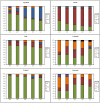Laboratory-based surveillance of Neisseria meningitidis isolates from disease cases in Latin American and Caribbean countries, SIREVA II 2006-2010
- PMID: 22952888
- PMCID: PMC3431326
- DOI: 10.1371/journal.pone.0044102
Laboratory-based surveillance of Neisseria meningitidis isolates from disease cases in Latin American and Caribbean countries, SIREVA II 2006-2010
Abstract
Background: Published data on the epidemiology of meningococcal disease in Latin America and the Caribbean region is scarce and, when available, it is often published in Spanish and/or in non-peer-reviewed journals, making it difficult for the international scientific community to have access.
Methods: Laboratory data on 4,735 Neisseria meningitidis strains was collected and reported by the National Reference Laboratories in 19 Latin American countries and the Caribbean Epidemiology Centre (CAREC) between 2006 and 2010 as part of the work carried out by the SIREVA II network. Serogroup and MIC to penicillin, rifampin and chloramphenicol were determined.
Results: Isolates were mainly obtained from patients <5 years, but each year around 25% of isolates came from adult patients. Serogroup distribution was highly variable among countries. Serogroup C was the main cause of disease in Brazil; the majority of disease seen in the Southern cone was caused by serogroup B, but serogroup W135 strains have increased in recent years. In the Andean and Mexico, Central America and Caribbean regions, serogroups B and C were equally present, and serogroup Y was frequently isolated. Isolates were generally susceptible to chloramphenicol, penicillin and rifampin, but almost 60% of isolates characterized in Southern cone countries presented intermediate resistance to penicillin. Five rifampin-resistant isolates have been isolated in Uruguay and Brazil.
Conclusions: Serogroup distribution is highly variable among countries, but some geographic structuring can be inferred from these data. Epidemiological and laboratory data are scarce among Andean and Mexico, Central America and Caribbean countries. Evaluation and implementation of corrective measures on disease surveillance and reporting systems and the implementation of molecular diagnostic techniques and molecular characterization on meningococcal isolates are advised.
Conflict of interest statement
Figures



References
-
- Rosenstein NE, Perkins BA, Stephens DS, Popovic T, Hughes JM (2001) Meningococcal disease. N Engl J Med 344: 1378–1388. - PubMed
-
- Aguilar-Garcia J, Olalla-Sierra J, Perea-Milla E, Rivas-Ruiz F, Martos F, et al. (2009) Analysis of the epidemiological characteristics and prognostic factors in probable or confirmed invasive meningococcal disease in a cohort of adolescents and adults during an epidemic outbreak. Rev Clin Esp 209: 221–226. - PubMed
-
- Deghmane AE, Parent du Chatelet I, Szatanik M, Hong E, Ruckly C, et al. (2010) Emergence of new virulent Neisseria meningitidis serogroup C sequence type 11 isolates in France. J Infect Dis 202: 247–250. - PubMed
-
- Jardine A, Truman G, Sheppeard V, Gibbons D, Thomas J, et al. (2009) A community outbreak of meningococcal serogroup B disease in western Sydney: the challenges of identification and significance. Commun Dis Intell 33: 221–224. - PubMed
Publication types
MeSH terms
Substances
LinkOut - more resources
Full Text Sources
Medical

